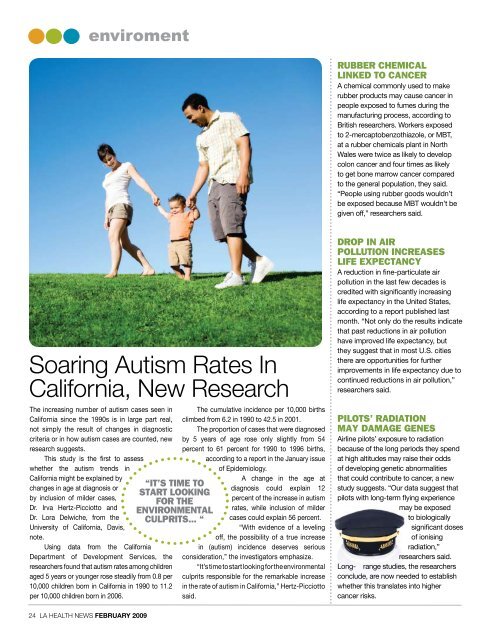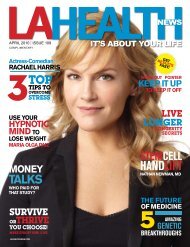JUSTIN HARTLEY SKINNY JEANS - LA Health News
JUSTIN HARTLEY SKINNY JEANS - LA Health News
JUSTIN HARTLEY SKINNY JEANS - LA Health News
You also want an ePaper? Increase the reach of your titles
YUMPU automatically turns print PDFs into web optimized ePapers that Google loves.
enviroment<br />
Soaring Autism Rates In<br />
California, New Research<br />
The increasing number of autism cases seen in<br />
California since the 1990s is in large part real,<br />
not simply the result of changes in diagnostic<br />
criteria or in how autism cases are counted, new<br />
research suggests.<br />
This study is the first to assess<br />
whether the autism trends in<br />
California might be explained by<br />
changes in age at diagnosis or<br />
by inclusion of milder cases,<br />
Dr. Irva Hertz-Picciotto and<br />
Dr. Lora Delwiche, from the<br />
University of California, Davis,<br />
note.<br />
Using data from the California<br />
Department of Development Services, the<br />
researchers found that autism rates among children<br />
aged 5 years or younger rose steadily from 0.8 per<br />
10,000 children born in California in 1990 to 11.2<br />
per 10,000 children born in 2006.<br />
24 <strong>LA</strong> HEALTH NEWS FEBRUARY 2009<br />
“IT’S TIME TO<br />
START LOOKING<br />
FOR THE<br />
ENVIRONMENTAL<br />
CULPRITS... “<br />
The cumulative incidence per 10,000 births<br />
climbed from 6.2 in 1990 to 42.5 in 2001.<br />
The proportion of cases that were diagnosed<br />
by 5 years of age rose only slightly from 54<br />
percent to 61 percent for 1990 to 1996 births,<br />
according to a report in the January issue<br />
of Epidemiology.<br />
A change in the age at<br />
diagnosis could explain 12<br />
percent of the increase in autism<br />
rates, while inclusion of milder<br />
cases could explain 56 percent.<br />
“With evidence of a leveling<br />
off, the possibility of a true increase<br />
in (autism) incidence deserves serious<br />
consideration,” the investigators emphasize.<br />
“It’s time to start looking for the environmental<br />
culprits responsible for the remarkable increase<br />
in the rate of autism in California,” Hertz-Picciotto<br />
said.<br />
RUBBER CHEMICAL<br />
LINKED TO CANCER<br />
A chemical commonly used to make<br />
rubber products may cause cancer in<br />
people exposed to fumes during the<br />
manufacturing process, according to<br />
British researchers. Workers exposed<br />
to 2-mercaptobenzothiazole, or MBT,<br />
at a rubber chemicals plant in North<br />
Wales were twice as likely to develop<br />
colon cancer and four times as likely<br />
to get bone marrow cancer compared<br />
to the general population, they said.<br />
“People using rubber goods wouldn’t<br />
be exposed because MBT wouldn’t be<br />
given off,” researchers said.<br />
DROP IN AIR<br />
POLLUTION INCREASES<br />
LIFE EXPECTANCY<br />
A reduction in fine-particulate air<br />
pollution in the last few decades is<br />
credited with significantly increasing<br />
life expectancy in the United States,<br />
according to a report published last<br />
month. “Not only do the results indicate<br />
that past reductions in air pollution<br />
have improved life expectancy, but<br />
they suggest that in most U.S. cities<br />
there are opportunities for further<br />
improvements in life expectancy due to<br />
continued reductions in air pollution,”<br />
researchers said.<br />
PILOTS’ RADIATION<br />
MAY DAMAGE GENES<br />
Airline pilots’ exposure to radiation<br />
because of the long periods they spend<br />
at high altitudes may raise their odds<br />
of developing genetic abnormalities<br />
that could contribute to cancer, a new<br />
study suggests. “Our data suggest that<br />
pilots with long-term flying experience<br />
may be exposed<br />
to biologically<br />
significant doses<br />
of ionising<br />
radiation,”<br />
researchers said.<br />
Long- range studies, the researchers<br />
conclude, are now needed to establish<br />
whether this translates into higher<br />
cancer risks.



